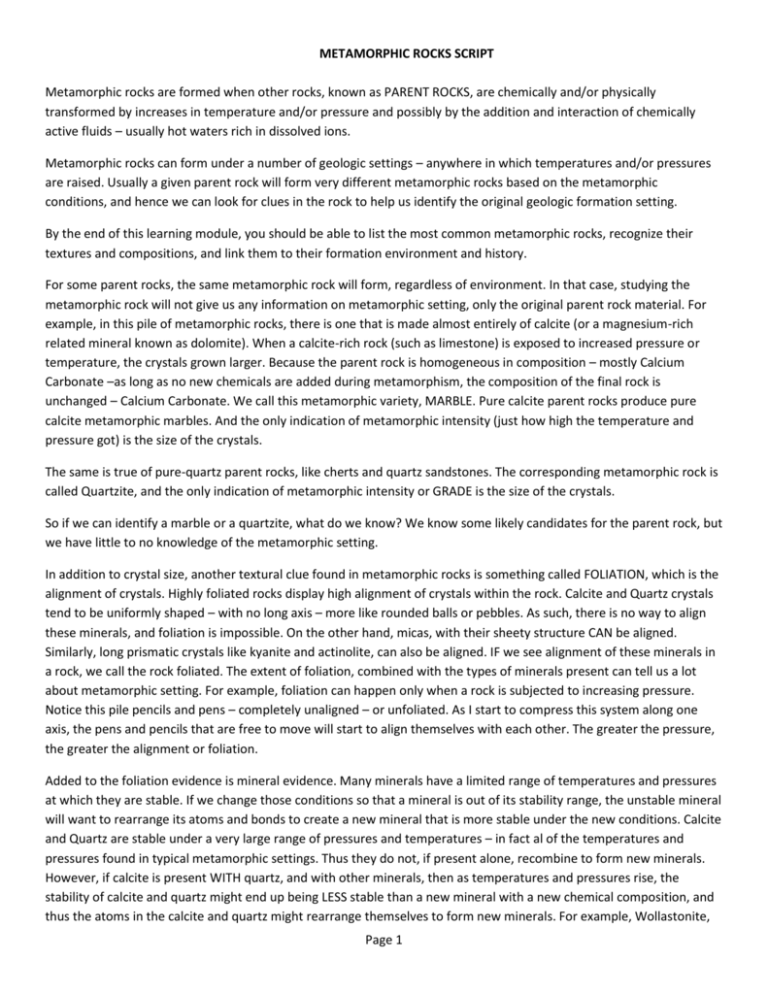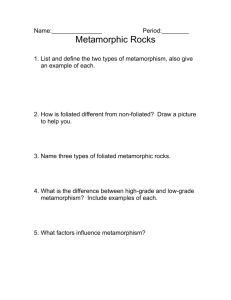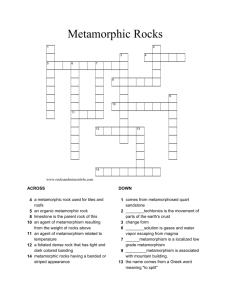METAMORPHIC ROCKS SCRIPT
advertisement

METAMORPHIC ROCKS SCRIPT Metamorphic rocks are formed when other rocks, known as PARENT ROCKS, are chemically and/or physically transformed by increases in temperature and/or pressure and possibly by the addition and interaction of chemically active fluids – usually hot waters rich in dissolved ions. Metamorphic rocks can form under a number of geologic settings – anywhere in which temperatures and/or pressures are raised. Usually a given parent rock will form very different metamorphic rocks based on the metamorphic conditions, and hence we can look for clues in the rock to help us identify the original geologic formation setting. By the end of this learning module, you should be able to list the most common metamorphic rocks, recognize their textures and compositions, and link them to their formation environment and history. For some parent rocks, the same metamorphic rock will form, regardless of environment. In that case, studying the metamorphic rock will not give us any information on metamorphic setting, only the original parent rock material. For example, in this pile of metamorphic rocks, there is one that is made almost entirely of calcite (or a magnesium-rich related mineral known as dolomite). When a calcite-rich rock (such as limestone) is exposed to increased pressure or temperature, the crystals grown larger. Because the parent rock is homogeneous in composition – mostly Calcium Carbonate –as long as no new chemicals are added during metamorphism, the composition of the final rock is unchanged – Calcium Carbonate. We call this metamorphic variety, MARBLE. Pure calcite parent rocks produce pure calcite metamorphic marbles. And the only indication of metamorphic intensity (just how high the temperature and pressure got) is the size of the crystals. The same is true of pure-quartz parent rocks, like cherts and quartz sandstones. The corresponding metamorphic rock is called Quartzite, and the only indication of metamorphic intensity or GRADE is the size of the crystals. So if we can identify a marble or a quartzite, what do we know? We know some likely candidates for the parent rock, but we have little to no knowledge of the metamorphic setting. In addition to crystal size, another textural clue found in metamorphic rocks is something called FOLIATION, which is the alignment of crystals. Highly foliated rocks display high alignment of crystals within the rock. Calcite and Quartz crystals tend to be uniformly shaped – with no long axis – more like rounded balls or pebbles. As such, there is no way to align these minerals, and foliation is impossible. On the other hand, micas, with their sheety structure CAN be aligned. Similarly, long prismatic crystals like kyanite and actinolite, can also be aligned. IF we see alignment of these minerals in a rock, we call the rock foliated. The extent of foliation, combined with the types of minerals present can tell us a lot about metamorphic setting. For example, foliation can happen only when a rock is subjected to increasing pressure. Notice this pile pencils and pens – completely unaligned – or unfoliated. As I start to compress this system along one axis, the pens and pencils that are free to move will start to align themselves with each other. The greater the pressure, the greater the alignment or foliation. Added to the foliation evidence is mineral evidence. Many minerals have a limited range of temperatures and pressures at which they are stable. If we change those conditions so that a mineral is out of its stability range, the unstable mineral will want to rearrange its atoms and bonds to create a new mineral that is more stable under the new conditions. Calcite and Quartz are stable under a very large range of pressures and temperatures – in fact al of the temperatures and pressures found in typical metamorphic settings. Thus they do not, if present alone, recombine to form new minerals. However, if calcite is present WITH quartz, and with other minerals, then as temperatures and pressures rise, the stability of calcite and quartz might end up being LESS stable than a new mineral with a new chemical composition, and thus the atoms in the calcite and quartz might rearrange themselves to form new minerals. For example, Wollastonite, Page 1 CaSiO3, might be more stable. So the stability of a mineral depends on temperature, pressure, AND chemical composition of the parent rock and any introduced chemicals from active fluids. It’s important to note here that when chemical constituents of a metamorphic rock rearrange themselves, they do so WITHOUT melting the rock. How? Increased temperatures will increase the motion of the atoms in the solid, and if that vibrational energy is high enough, the atoms can jump around in the solid and do things like clean up their crystal structures (remove imperfections), combine to form larger crystals, and rearrange into more stable compounds. So we can separate metamorphic rocks into three piles: FOLIATED, NONFOLIATED, and WEAKLY FOLIATED. Now let’s go to the nonfoliated rocks. If these contain minerals that “could” foliate, but haven’t, then what do we know? The rock has NOT been subjected to high pressures. The only metamorphic settings in which there is little to no increased pressure are contact metamorphism (heating up rocks around a magma chamber) and hydrothermal metamorphism (hot waters percolating through cracks or pores in the rock). When the nonfoliated rock contains a mixture of large crystals, such as this one, with some calcite, some quartz, some garnet, and some epidote, we call the final rock SKARN. Skarns are rocks that form in a contact metamorphic environment with high temperatures and likely high amounts of chemically active fluids, but with little to no pressure. We would find these environments underground at all volcanic settings, such as hotspot volcanism, divergent plate boundary volcanism, and subduction zone volcanism. A sandstone that contains some mineral and rock fragments PLUS some shell fragments would be a good parent rock for a skarn. The mineral compositions and sizes that we find in a skarn can further tell us how much temperature and what kinds of fluids were available. We would expect to see the minerals stable at the highest temperatures in a zone closest to the magma chamber and those indicating lower temperature stabilities further away. This other rock that is dark black with a sugary texture is called HORNFELS. It is also nonfoliated, so also found in the same settings just described for SKARN, but it’s what results when the parent rock was a mudstone or basalt. Let’s pause for a moment and review all our nonfoliated rocks: Marble, Quartzite, Skarn, and Hornfels. All of these can form in a contact metamorphism setting, and each is transformed in that same setting to a different rock product, not because of different temperatures and pressures, but because the original parent rock differed. Of course the marble and quartzite could also have formed in another other setting as we’ve already discussed, so let’s set them aside and return to our foliated rocks. Rocks with clear foliation show a clear alignment of minerals, either in visible bands or microscopically as micas that are aligned and give the rock a sheety or slaty cleavage. Last week we talked about how mud-sized clays can collect at the bottom of lakes or the ocean floor and get buried and compressed or cemented to form mudstone. Continued compaction will align the clay minerals, which are sheet silicates, with sheety cleavage, and that gives the rock a planar fabric. A little bit of compression means we get a sedimentary rock called SHALE. A bit more compression moves us into the metamorphic realm. The clays are beginning to change chemically into other sheet silicates such as chlorite or muscovite or biotite. These perfectly aligned microscopic sheet silicates give the rock slaty cleavage, and the rock is called SLATE. You can see how dense it is. In fact, you can even hear a difference among these three rocks – mudstone is less dense and compacted – shale is more dense and compacted – slate is the most dense and compacted. Continued metamorphism leads to larger and larger crystals, like biotite, which as they grow, begin to give the rock a satiny luster. Sometimes other minerals will form, as large crystals surrounded by a sea of microcrystalline biotite. Those larger crystals are called PORPHYROBLASTS. They form by the movement of atoms WITHIN a solid – no melt – just migration. This process allows the crystals to grow quite large and with perfect edges. Pyrites and garnets are common porphyroblasts in metamorphic rocks. This satiny phase of foliated rock, with or without porphyroblasts, is called Page 2 PHYLLITIC texture, and the rock is called a PHYLLITE. As metamorphic intensity or GRADE increases, the mica crystals become visible to the naked eye. They can grow so large they give the rock a scaly appearance. We call this texture SCHISTOSITY. And the rock is called a SCHIST. This rock in particular is called a garnet schist because of the garnet porphyroblasts. As metamorphic grade continues to increase, the dark- and light-colored minerals begin to separate into bands known as GNEISSIC TEXTURE. And the rock is a GNEISS. Gneiss form through high grades of metamorphism of mudstone or granites in settings where pressures increases with temperature, such as deep burial, converging continents, or subduction zones. Increasing temperatures at this point can cause the light-colored bands to melt, so that half or a fraction of the rock is molten, but not all of it. This situation leads to folding of the bands and a rock displaying contorted, folded alternating colored bands. When the molten bits solidify, they create small layers of granite within the metamorphic rock. We call this rock a MIGMATITE. Any further increase of temperature will cause full rock melting and lead to igneous rocks. Any unusual porphyroblasts or minerals we see in this sequence of rocks can help us further identify the exact pressures and temperatures to which the rock was subjected. For example, garnets typify medium to high temperatures and pressures. Now what about these rocks – which can show some weak foliation, but not the same as shown in this sequence of increasing grades of pressure of mudstone. Let’s start with this familiar green rock made entirely of the mineral serpentine. The rock is called SERPENTINITE, and it forms when olivine is hydrothermally metamorphosed. A typical geologicl setting for this California State Rock is deep under a mid-ocean ridge, where seawater penetrates cracks, is heated up by magmas, and then interacts with mantle rock, rich in olivine – where that rock is closest to the surface because of the thin crust. After serpentinite forms in such a setting it takes advantage of any and all opportunities to rise upward along cracks in the rocks, because its density is so much lower than the surrounding rocks. As such, we typically find serpentinite migrating up subduction zones and accreting to the edge of the continent as terranes accrete. We also see it migrating up transform faults and fracture zones on the bottom of the seafloor, creating serpentinite ridges. These other two rocks represent the metamorphism of basalt. When basalt is subjected to low grade metamorphism in a burial setting, converging continents, or subduction zone, small crystals of chlorite, epidote, and/or actinolite begin to form. This produces a fine-grained, dense green rock called GREENSTONE. Usually it still retains much of the shape and texture of the original basalt. If this rock undergoes increasing pressure and temperature in a converging continents or deep burial setting, the crystals will grow larger and eventually actinolite crystals will dominate the rock. We then call it a GREENSCHIST. If the greenstone is in a subduction zone environment, on the other hand, where pressures quickly rise while temperatures lag behind (and where water contents are high), this rock, BLUESCHIST will form, followed by this rock, ECLOGITE, at the highest grade of subduction. Blueschist is a fine-grained bluish-colored schist, dominated by blue amphiboles and other silicates. Eclogite is distinguished by its green groundmass (produced by small green pyroxene crystals, a different variety than the one we saw in the minerals lab) and scattered red garnets. It also can contain some kyanite crystals, which only form at the highest pressures in a subduction zone environment. So looking at these rocks again, all together, we see that with metamorphic rocks in particular, the identification and naming process leads directly to the parent rock and metamorphic formation setting. Once you name a metamorphic rock, you can learn quite a lot about its formation history. For example, which of these rocks had basalt as a parent Page 3 rock? If basalt is placed in a contact metamorphic setting, it turns to hornfels. If it’s placed in a subduction zone, it turns to greenstone, then blueschist, then eclogite. If it’s buried deeply, it becomes greenstone, then greenschist, then a rock we didn’t include here called amphibolite. And a mudstone? It turns to hornfels in a high temperature low pressure environment, and a slate, phyllite, schist, gneiss, or migmatite in increasing grade in a high pressure environment. Serpentinite forms through hydrothermal metamorphism of peridotite at mid-ocean ridge. And contact metamorphism of mixture of minerals, like a greywacke sandstone, leads to a skarn. And remember what happens to a limestone or chert? Limestone turns to marble, and chert turns to quartzite, in any and all metamorphic settings. In this review of some basic metamorphic rock types, we have greatly simplified the very complicated field of metamorphic petrology. Our goal was to simply give you a starter’s guide for identifying the most basic and common metamorphic rocks – which you are likely to encounter as you travel the world’s outcrops. Page 4








